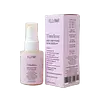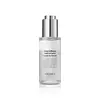What's inside
What's inside
 Key Ingredients
Key Ingredients

 Benefits
Benefits

 Ingredients Side-by-side
Ingredients Side-by-side

Water
Skin ConditioningLysine
Skin ConditioningHistidine
HumectantArginine
MaskingAspartic Acid
MaskingThreonine
Serine
MaskingGlutamic Acid
HumectantProline
Skin ConditioningGlycine
BufferingAlanine
MaskingValine
MaskingMethionine
Skin ConditioningIsoleucine
Skin ConditioningLeucine
Skin ConditioningTyrosine
MaskingPhenylalanine
MaskingCysteine
AntioxidantHydrolyzed Psoralea Corylifolia Extract
Skin ConditioningSodium Hyaluronate
HumectantNiacinamide
SmoothingAcetyl Glucosamine
Skin ConditioningCentella Asiatica Extract
CleansingMorus Alba Bark Extract
Skin ConditioningPyrus Malus Fruit Extract
Skin ConditioningCamellia Sinensis Leaf Extract
AntimicrobialBroussonetia Kazinoki Root Extract
Skin ConditioningGalactoarabinan
Camellia Japonica Leaf Extract
Skin ConditioningAcacia Senegal Gum
MaskingHydrolyzed Rhizobian Gum
Sodium Lactate
BufferingSodium Glutamate
MaskingEthylhexylglycerin
Skin ConditioningPhenoxyethanol
PreservativeSodium Citrate
BufferingWater, Lysine, Histidine, Arginine, Aspartic Acid, Threonine, Serine, Glutamic Acid, Proline, Glycine, Alanine, Valine, Methionine, Isoleucine, Leucine, Tyrosine, Phenylalanine, Cysteine, Hydrolyzed Psoralea Corylifolia Extract, Sodium Hyaluronate, Niacinamide, Acetyl Glucosamine, Centella Asiatica Extract, Morus Alba Bark Extract, Pyrus Malus Fruit Extract, Camellia Sinensis Leaf Extract, Broussonetia Kazinoki Root Extract, Galactoarabinan, Camellia Japonica Leaf Extract, Acacia Senegal Gum, Hydrolyzed Rhizobian Gum, Sodium Lactate, Sodium Glutamate, Ethylhexylglycerin, Phenoxyethanol, Sodium Citrate
Hydrolyzed Collagen Extract
Skin ProtectingGlycerin
HumectantPropanediol
SolventValine
MaskingHydrogenated Polyisobutene
EmollientNeopentyl Glycol Diheptanoate
EmollientLeucine
Skin ConditioningGlycereth-26
Humectant1,2-Hexanediol
Skin ConditioningDicaprylyl Carbonate
EmollientNiacinamide
SmoothingButylene Glycol
HumectantSoluble Collagen
HumectantHydrolyzed Collagen
EmollientWater
Skin ConditioningAtelocollagen
Skin ConditioningAdenosine
Skin ConditioningAnemarrhena Asphodeloides Root Extract
Skin ConditioningSerine
MaskingGlutamic Acid
HumectantProline
Skin ConditioningSodium Hyaluronate
HumectantAspartic Acid
MaskingAlanine
MaskingLysine
Skin ConditioningChondrus Crispus Extract
Skin ConditioningGlycine
BufferingArginine
MaskingTyrosine
MaskingPhenylalanine
MaskingThreonine
Isoleucine
Skin ConditioningTocopherol
AntioxidantHistidine
HumectantCysteine
AntioxidantMethionine
Skin ConditioningHydrolyzed Elastin
EmollientHyaluronic Acid
HumectantHydroxypropyltrimonium Hyaluronate
Sodium Acetate
BufferingCellulose
AbsorbentHydrolyzed Hyaluronic Acid
HumectantSodium Acetylated Hyaluronate
HumectantHydrolyzed Sodium Hyaluronate
Skin ConditioningSodium Hyaluronate Crosspolymer
HumectantPotassium Hyaluronate
Skin ConditioningEthylhexylglycerin
Skin ConditioningTrilaureth-4 Phosphate
EmulsifyingHydroxyethylcellulose
Emulsion StabilisingDisodium EDTA
Hydrolyzed Collagen Extract, Glycerin, Propanediol, Valine, Hydrogenated Polyisobutene, Neopentyl Glycol Diheptanoate, Leucine, Glycereth-26, 1,2-Hexanediol, Dicaprylyl Carbonate, Niacinamide, Butylene Glycol, Soluble Collagen, Hydrolyzed Collagen, Water, Atelocollagen, Adenosine, Anemarrhena Asphodeloides Root Extract, Serine, Glutamic Acid, Proline, Sodium Hyaluronate, Aspartic Acid, Alanine, Lysine, Chondrus Crispus Extract, Glycine, Arginine, Tyrosine, Phenylalanine, Threonine, Isoleucine, Tocopherol, Histidine, Cysteine, Methionine, Hydrolyzed Elastin, Hyaluronic Acid, Hydroxypropyltrimonium Hyaluronate, Sodium Acetate, Cellulose, Hydrolyzed Hyaluronic Acid, Sodium Acetylated Hyaluronate, Hydrolyzed Sodium Hyaluronate, Sodium Hyaluronate Crosspolymer, Potassium Hyaluronate, Ethylhexylglycerin, Trilaureth-4 Phosphate, Hydroxyethylcellulose, Disodium EDTA
Ingredients Explained
These ingredients are found in both products.
Ingredients higher up in an ingredient list are typically present in a larger amount.
Alanine is an amino acid and is already found in the human body. Our skin uses alanine to build collagen, elastin, and keratin.
Arginine is an amino acid that is important for human development. Your body uses is it to produce hair keratin and skin collagen.
As a cosmetic ingredient, Arginine has antioxidant properties and can also help repair damaged skin. This ingredient is derived either synthetically or from animals.
Arginine isn't fungal acne safe when used in the presence of other lipids (fats, fatty acids, oils, esters, etc). Oils and fats occur naturally within the skin, so take caution when using Arginine if you're prone to fungal acne.
Learn more about ArginineAspartic Acid is an amino acid that our bodies produce naturally. It is an antioxidant.
Our body uses Aspartic Acid to help build collagen and elastin. It also plays a role in hydrating skin.
Cysteine is an amino acid found in our bodies. It becomes an antioxidant when converted into gluthatione.
Once it becomes gluthatione, it prevents oxidative damage to parts of our cell. Gluthatione has also been shown to protect our skin from UV-B induced damage.
Ethylhexylglycerin (we can't pronounce this either) is commonly used as a preservative and skin softener. It is derived from glyceryl.
You might see Ethylhexylglycerin often paired with other preservatives such as phenoxyethanol. Ethylhexylglycerin has been found to increase the effectiveness of these other preservatives.
Glutamic Acid is an amino acid that is found in all living organisms. Our bodies use this to help nerve cells in the brain communicate with other cells.
In cosmetics, glutamic acid is a famous humectant. It draws water from the air to your skin, keeping your skin hydrated (like hyaluronic acid).
An in-vitro study from 2024 found glutamic acid to play a role in inhibiting inflammation and thus a potential skin-soothing ingredient.
Other studies show it to be have potential wound healing, skin barrier repair, and hair growth properties.
Glutamic acid has poor solubility in water and other solvents.
Learn more about Glutamic AcidThis ingredient is an amino acid that helps build proteins and moisturizes skin. It is already present in our skin as our bodies produce them naturally.
Glycine already plays a role in helping keep our skin moisturized as amino acids transport moisture throughout our skin.
As collagen is made up of glycine and other amino acids, it is believed glycine may help our skin produce more collagen.
Learn more about GlycineHistidine is a semi-essential amino acid used by our bodies to create protein. It has humectant and skin conditioning properties.
Our bodies use histidine to create filaggrin - filaggrin is a structural protein that the skin uses in maintaining skin barrier.
One study found histidine and carnosine to be a dynamic duo for your skin:
Oral histidine has also been found to help with filaggrin-deficit skin disorders such as atopic dermatitis.
Why is it considered a semi-essential amino acid? This is because adults are able to create it but children must get it from their diet.
Learn more about HistidineIsoleucine is an amino acid that helps reinforce our skin barrier. This amino acid plays a role in creating protein for the body.
Fun fact: Isoleucine is found in meat, fish, dairy, legumes, and nuts.
We don't have a description for Leucine yet.
Lysine is an essential amino acid. Your body is unable to produce it naturally and we mainly get lysine from food sources.
Our bodies use lysine for growth and tissue repair. The skin uses amino acids as a precursor for building protein, and therefore keratins, collagen and elastin.
Methionine is an essential amino acid. It is a conditioning agent and commonly found in both skin and hair products.
This amino acid is a precursor to glutathione, a powerful antioxidant.
Fun fact: Methionine can be found in meat, fish, and dairy. It cannot be naturally produce and requires dietary intake.
Learn more about MethionineNiacinamide is a multitasking form of vitamin B3 that strengthens the skin barrier, reduces pores and dark spots, regulates oil, and improves signs of aging.
And the best part? It's gentle and well-tolerated by most skin types, including sensitive and reactive skin.
You might have heard of "niacin flush", or the reddening of skin that causes itchiness. Niacinamide has not been found to cause this.
In very rare cases, some individuals may not be able to tolerate niacinamide at all or experience an allergic reaction to it.
If you are experiencing flaking, irritation, and dryness with this ingredient, be sure to double check all your products as this ingredient can be found in all categories of skincare.
When incorporating niacinamide into your routine, look out for concentration amounts. Typically, 5% niacinamide provides benefits such as fading dark spots. However, if you have sensitive skin, it is better to begin with a smaller concentration.
When you apply niacinamide to your skin, your body converts it into nicotinamide adenine dinucleotide (NAD). NAD is an essential coenzyme that is already found in your cells as "fuel" and powers countless biological processes.
In your skin, NAD helps repair cell damage, produce new healthy cells, support collagen production, strengthen the skin barrier, and fight environmental stressors (like UV and pollution).
Our natural NAD levels start to decline with age, leading to slower skin repair, visible aging, and a weaker skin barrier. By providing your skin niacinamide, you're recharging your skin's NAD levels. This leads to stronger, healthier, and younger looking skin.
Another name for vitamin B3 is nicotinamide. This vitamin is water-soluble and our bodies don't store it. We obtain Vitamin B3 from either food or skincare. Meat, fish, wheat, yeast, and leafy greens contain vitamin B3.
The type of niacinamide used in skincare is synthetically created.
Learn more about NiacinamidePhenylalanine is an amino acid. It is a skin soothing and hydrating ingredient. Amino acids play a crucial role in wound healing and skin hydration.
This ingredient is also used to help even out skin tone due to its ability to disrupt the melanin production process.
Two structures of phenylalanine exist: L-phenylalanine and D-phenylalanine. L-phenylalanine is essential, this means our bodies cannot produce it naturally and we must get it from foods. Our bodies convert D-phenylalanine to neurotransmitters, and D-phenylalanine is found in our bodies naturally.
Some foods that contain L-phenylalanine include eggs, soybeans, beef, milk.
Learn more about PhenylalanineProline is an amino-acid. It helps moisturize the skin and plays an important role in creating proteins.
Our skin uses proline as one of the building blocks for producing collagen.
In medicine, proline is used as an osmoprotectant. This means it helps prevent oxidative degradation in other drugs.
Our bodies are able to produce proline naturally, but certain conditions may inhibit this production. In that case, proline can be obtained from eating egg whites, soy protein, dairy products, asparagus, mushrooms, and seaweed.
Learn more about ProlineSerine is an amino acid naturally found in our body. Our bodies use amino acids to create protein.
Amino-acids help give keep our skin hydrated. They play an important role in the skin barrier, which keeps the skin plump and firm.
Serine is a non-essential amino acid, meaning we don't need to obtain it from eating foods.
Learn more about SerineSodium Hyaluronate is hyaluronic acid's salt form. It is commonly derived from the sodium salt of hyaluronic acid.
Like hyaluronic acid, it is great at holding water and acts as a humectant. This makes it a great skin hydrating ingredient.
Sodium Hyaluronate is naturally occurring in our bodies and is mostly found in eye fluid and joints.
These are some other common types of Hyaluronic Acid:
Learn more about Sodium HyaluronateThreonine is an amino-acid. It helps hydrate the skin and has antioxidant benefits.
Our skin uses threonine for creating collagen and elastin. Humans are not able to create threonine and must get it through eating foods such as fish, lentils, poultry, sesame seeds, and more.
Tyrosine is one of the amino acids used to create protein. It plays a role in melanin production.
A study from 2012 found tyrosine to show promising results in restoring skin volume.
Valine is an essential amino acid. It is used by our bodies for tissue repair and muscle growth.
An essential amino acid is one in which our bodies cannot naturally produce so we must get them through diet. Foods such as eggs, dairy, red meat, and fish contain valine.
This ingredient can either be derived from an animal product or be synthetically created.
Learn more about ValineWater. It's the most common cosmetic ingredient of all. You'll usually see it at the top of ingredient lists, meaning that it makes up the largest part of the product.
So why is it so popular? Water most often acts as a solvent - this means that it helps dissolve other ingredients into the formulation.
You'll also recognize water as that liquid we all need to stay alive. If you see this, drink a glass of water. Stay hydrated!
Learn more about Water